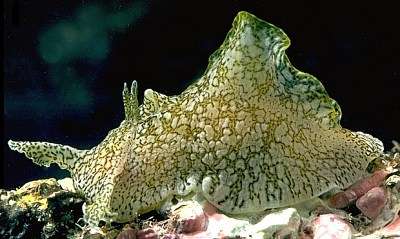
Syphonota geographica
(Adams & Reeve, 1850)
Order: ANASPIDEA
Superfamily: APLYSIOIDEA
Family: Aplysiidae
DISTRIBUTION
Indo-West Pacific & Atlantic. [Recorded here from Caribbean, and as a possible Lessepsian migrant to Mediterranean]
PHOTO
Lagoon between mainland & Récif de l'Infernet, 10-11m, off Koumac, New Caledonia, sand & grey mud, October 1993, many specimens seen,(58 - 99mm long alive). LOWER LEFT: showing range of colour variation. LOWER RIGHT: with parapodial flaps opened to show the mantle covering the shell and the posteriorly pointing exhalent siphon. The ring at the centre of the radiating green pattern on the mantle is the edge of the mantle 'foramen'. The foramen is a hole through to the cavity in which the shell sits. PHOTOS: Bill Rudman.
This circumtropical species can be distinguished from species of Aplysia by the position of the rhinophores, close together and set back between the parapodial lobes. They swim by flapping the parapodia. Also known as Paraplysia piperata (Smith, 1884) and Aplysia scripta Bergh, 1905. The name geographica refers to the map-like nature of the colour pattern and scripta also refers to the colour pattern, Bergh being reminded of Arabic writing.
Reference:
• Adams, A. & Reeve, L. (1850). Mollusca, Part 3. In: Adams, A.(Ed.), The zoology of the voyage of the H.M.S. Samarang; under the command of Captain Sir Edward Belcher, C.B., F.R.A.S., F.G.S., during the years 1843-1846. pp. 45-87, Pls 17-24. Reeve, Benham & Reeve: London.
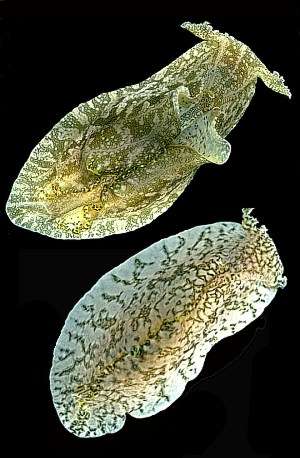
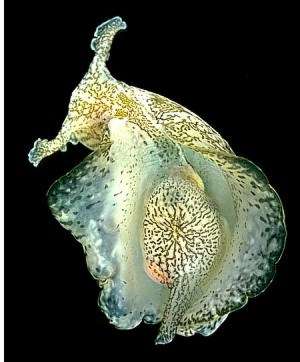
Rudman, W.B., 1999 (May 26) Syphonota geographica (Adams & Reeve, 1850). [In] Sea Slug Forum. Australian Museum, Sydney. Available from http://www.seaslugforum.net/find/syphgeog
Related messages
Seahare from Lembeh, Indonesia
November 9, 2009
From: Zeineb Alhaidari
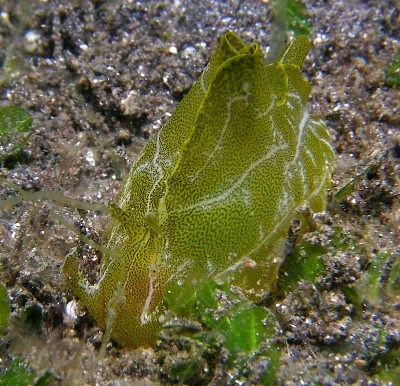
Dear Bill ,
I have not been able to put a name on this beautiful little seahare , observed on the dive site Nudi retreat at about 12 metres depth in Lembeh. Could you help?
Locality: Dive site : Nudi retreat , Lembeh strait, 12 metres, North Sulawesi , Indonesia, Molucca sea, 05 October 2009, Sand and sediment. Length: 8 cm. Photographer: Zeineb Alhaidari
Many thanks in advance, sincerely,
Zeineb
z.alhaidari@wanadoo.fr
Alhaidari , Z., 2009 (Nov 9) Seahare from Lembeh, Indonesia. [Message in] Sea Slug Forum. Australian Museum, Sydney. Available from http://www.seaslugforum.net/find/22759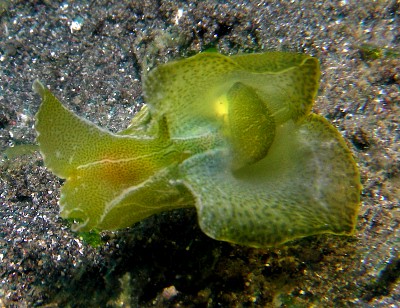
Dear Zeineb,
This is Syphonota geographica. This sea hare is found throughout the tropical Indo-West Pacific but records on the Forum from both the Mediterranean and the Caribbean show it is also found in the Atlantic. Whether it has recently moved to there through shipping or other human activity, or whether it has a 'natural' circum-tropical distribution still needs to be investigated.
Best wishes,
Bill Rudman
Syphonota geographica from South Africa
June 2, 2008
From: Valda Fraser
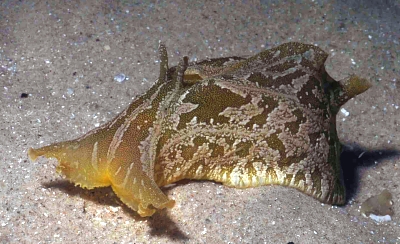
Dear Bill
Just look at this one! Cannot find it in any of my books. Sure you will find no trouble in trotting out the appropriate name. Thanks.
Locality: Pomene, 2 m, Mozambique, Indian, 8 May 2008, Estuary. Length: 80 mm. Photographer: Valda Fraser.
Regards
Valda
valdafraser@mweb.co.za
Fraser, V.J., 2008 (Jun 2) Syphonota geographica from South Africa. [Message in] Sea Slug Forum. Australian Museum, Sydney. Available from http://www.seaslugforum.net/find/21578Dear Valda,
This is Syphonota geographica. I am not sure if this species has been recorded from the southwestern Indian Ocean before. Gosliner (1987) lists Paraplysia lowii Gilchrist, 1900 from South Africa, which is possibly a synonym of S. geographica, but I haven't checked it out.
Best wishes,
Bill Rudman
Syphonata geographica eggs
February 25, 2008
From: Leanne & David Atkinson

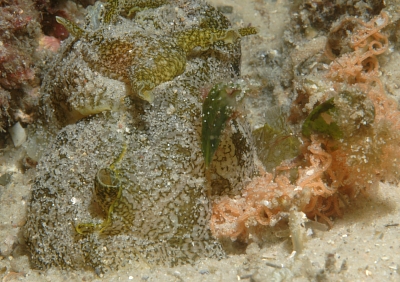
Hi Bill,
These photos show more of the Syphonata geographica aggregation [see message #21226] and the egg mass. Are they being laid in the photo we weren't sure? One of the earlier postings showed eggs like this near the Syphonata geographica. There is also a Halophilaseagrass leaf close by.
Locality: Fly Point, Port Stephens - Great Lakes Marine Park, Port Stephens, 8 metres, New South Wales, Australia, Pacific, 24 November 2007, Sandy bottom with scattered sponges, ascidians, gorgonias and seagrasses. Length: Approximately 130 mm. Photographer: Leanne & David Atkinson.
Regards,
Leanne & David Atkinson
atk@hunterlink.net.au
Atkinson, L. & D., 2008 (Feb 25) Syphonata geographica eggs. [Message in] Sea Slug Forum. Australian Museum, Sydney. Available from http://www.seaslugforum.net/find/21227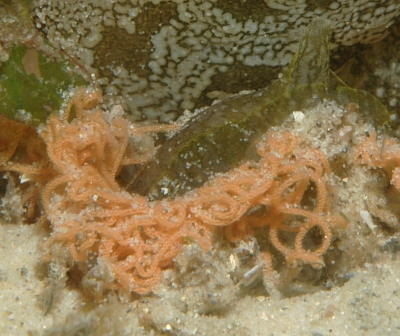
Dear Leanne & David,
I suspect these are the egg strings of Syphonota, but as they look quite similar to many other sea hares we can't be 100% sure unless we catch them in the act of laying.
Best wishes,
Bill Rudman
Syphonata geographica mating
February 25, 2008
From: Leanne & David Atkinson
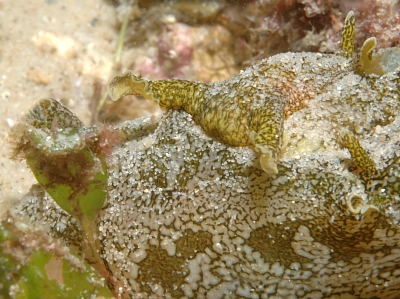
Hi Bill,
We found these Syphonata geographica in an aggregation. We counted three at the time but it is harder to see each of the individuals in the photos. Is the one on top in a mating position? They are covered in sand grains perhaps they recently emerged from the sand. This was early in the morning. Perhaps they sleep under the sand and emerge during the day. We also saw eggs beside them and will send a second message [#21227] with more egg photos.
Locality: Fly Point, Port Stephens - Great Lakes Marine Park, Port Stephens, 8 metres, New South Wales, Australia, Pacific, 24 November 2007, Sandy bottom scattered sponges, ascidians, gorgonians and seagrass. Length: approximately 120 mm. Photographer: Leanne & David Atkinson
Regards,
Leanne & David Atkinson
atk@hunterlink.net.au
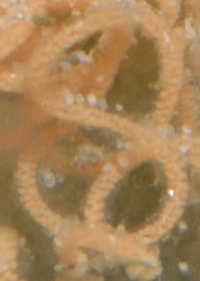
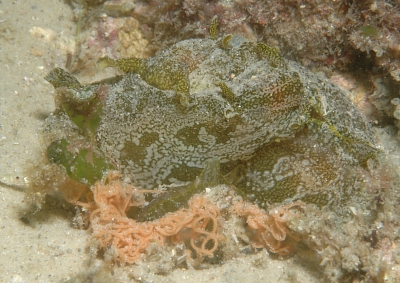

Dear Leanne & David,
I can't be sure they are mating but usually when sea hares are found crawling over each other like this there is bound to be some mating activity taking place. Thanks for the suggestion that they may be burying in the sand at night. Certainly the covering of sand would suggest as much - or at least that they have been 'ploughing' through the sand.
Best wishes,
Bill Rudman
Syphonata geographica feeding on Halophila
November 27, 2007
From: Leanne & David Atkinson
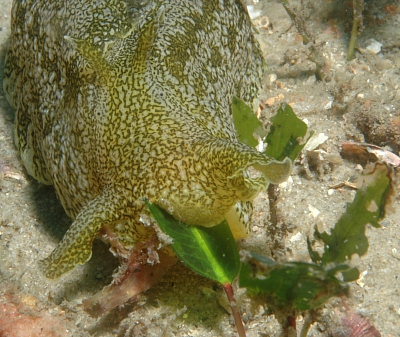
Hi Bill,
We've been finding a few Syphonota geographica in the same area as the Petalifera ramosa and some Aplysia sydneyensis so we have been watching closely to try to see what they eat and hoping to catch them laying eggs or mating. We found this Syphonata geographica grazing on the leaf shaped seaweed that we've been finding the Petalifera ramosa on. The Petaliferas seem to glide over as if they are grazing on something on the surface since there are no sign of damage. This Syphonata geographica just munches its way through the entire leaf. Here is an action sequence. Hope it is of interest. We haven't seen the burrowing under the sand as mentioned in other postings but there does seem to be a root system under the sand maybe they can camouflage and eat at the same time.
Locality: Fly Point, Marine Park, Port Stephens, 8 metres, New South Wales, Australia, Pacific, 10 November 2007, Sandy bottom scattered sponges, ascidians and seaweed. Length: approximately 130 mm. Photographer: Leanne & David Atkinson.
Hope this finds you well.
Regards,
Leanne & David Atkinson
atk@hunterlink.net.au
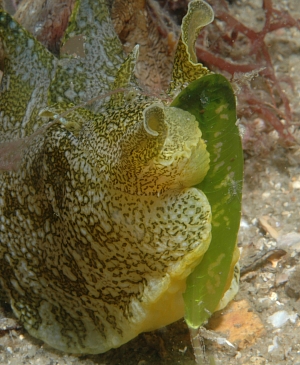
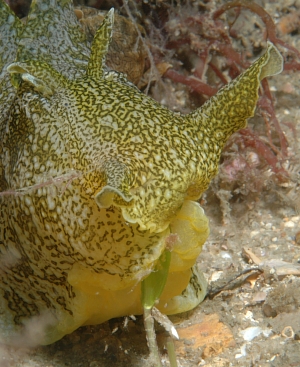
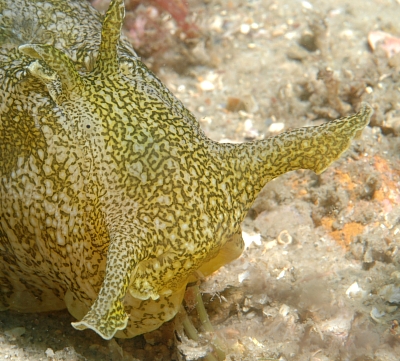
Dear Leanne & David,
This is a very interesting observation as I know of no direct observations of Syphonota feeding. The plant they are eating in your photos is a flowering plant rather than an algae. It is the sea grass Halophila, probably Halophila ovata, but I am no expert on sea grasses. There is an earlier message from Singapore [#9109] showing a Syphonota burrowing right by a clump of same sea grass which may be more than a coincidence.
Even more interesting is scientifc paper published earlier this year (Gavagnin et al, 2007) which reports on the secondary metabolites found in Syphonota, including one molecule that suggested that Syphonota geographica feeds on the sea grass Halophila stipulacea. As I said to Margherita Gavagnin at the time [message #20811] this type of research is proving to be a powerful tool in linking particular species to their food items.
Your observation certainly confirms this.
- M. Gavagnin, M. Carbone, P. Amodeo, E. Mollo, R. M. Vitale, V. Roussis and G. Cimino. (2007) Structure and absolute stereochemistry of syphonoside: a unique macrocyclic glycoterpenoid from marine organisms. J. Org. Chem., 72: 5625-5630.
Best wishes,
Bill Rudman
Re: Seahare from Singapore
March 29, 2007
From: Ron Yeo
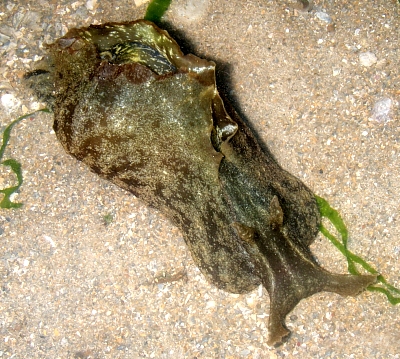
Hi Bill,
I've attached another picture here with a higher resolution. I have received feedback from another visitor from your site that it could be a Syphonota geographica. I'm not sure what is the identifying feature for the S. geographica is though.
Not sure if this helps, but when we placed the sea hare in a tidal pool, it started crawling of the water to the sandy edge, and appear like it was trying to burrow into the sand. But perhaps the sand was too firm, it only managed to get some sand over its body. The body was very smooth though, without any bumps.
Locality: Pulau Sekudu, intertidal, Singapore, South China Sea, 23 March 2007, Intertidal. Length: 100 mm. Photographer: Ron Yeo.
Thanks.
Ron
ronyeo@gmail.com
Yeo, R., 2007 (Mar 29) Re: Seahare from Singapore. [Message in] Sea Slug Forum. Australian Museum, Sydney. Available from http://www.seaslugforum.net/find/19776Dear Ron,
Thanks for this extra photo. It's always helpful to see an animal from different angles. Your anonymous Forum visitor is probably correct in suggesting this is Syphonota geographica, although the rhinophores are quite a bit further forward of the parapodia than I would have expected. It could be the head is stretching out quite a bit in this photo. External characters of Syphonota are quite difficult to define, but the rhinophores are relatively small and usually very near the parapodia, far back on the 'head'. The other general feature is that the body is usually more flattened than most species of Aplysia, and as you will see in other photos on the Forum it usually has a distinctive colour pattern. Interestingly we have a message on the Forum about a more typical looking Syphonota from Singapore [#9109 ], which reports them burrowing in the mud just as you have observed. Some species of Aplysia have also been reported burrowing, so it may just be a coincidence.
I am glad you received feedback from another Forum visitor. I know lots of secondary communication takes place between Forum visitors and participants and I welcome it, because that is part of the function of the Forum. However if any Forum visitor has a good idea, such as that this animal could be Syphonota, please share it wth us all by sending a message to the Forum. I welcome any help available.
Best wishes,
Bill Rudman
Syphonota geographica from Bali
February 19, 2007
From: Teresa (Zubi) Zuberbühler
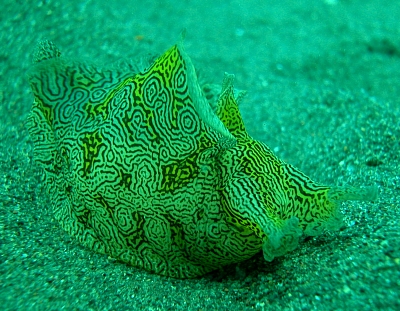
Dear Bill
I have found this beautiful seahare (Aplysia?) with markings like a labyrinth in a sandy area in Puri Jati, Bali. I couldn't find a photo of it in your extensive forum, so I would like to know, if it is a new species.
Locality: Puri Jati, Bali, 10m, Indonesia, Pacific , 10. August 2006, Sandy area close to beach, surge. Length: 8-10cm. Photographer: Teresa (Zubi) Zuberbühler.
Thanks for your help
Zubi
www.starfish.ch
webmaster@starfish.ch
Zuberbühler, T., 2007 (Feb 19) Syphonota geographica from Bali. [Message in] Sea Slug Forum. Australian Museum, Sydney. Available from http://www.seaslugforum.net/find/19467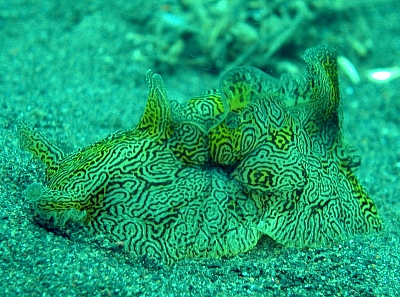
Dear Zubi,
The colour of this sea hare reminds me of Indonesian batik cloth. This is Syphonota geographica, a rather uniquely shaped sea hare. Interestingly the only other photos I have seen of one with yellow markings like this, is a recent message, also from Bali [message #19280 ].
Best wishes,
Bill Rudman
Syphonota geographica from northern Bali
January 31, 2007
From: Danny van Belle
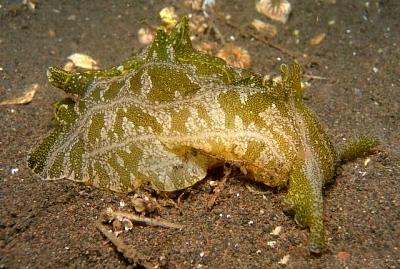
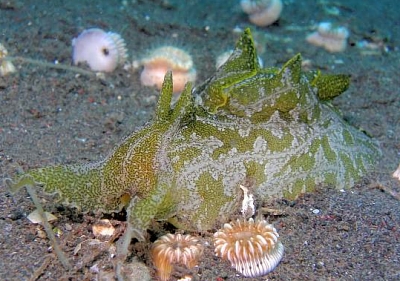
I think this is Syphonota geographica. It is pretty common at divesite Puri jati - North Bali.
It is sometimes found crawling around in daytime but when disturbed by videolights it tries to hide under the sand.
Locality: Puri Jati - Bali, 12 m, Indonesia, Indian ocean, 16 august 2006, Algea covered sandy area. Length: 8-10 cm. Photographer: Danny van Belle - Stephen Childs.
Danny van Belle
danny.van.belle@skynet.be
Danny Van Belle, 2007 (Jan 31) Syphonota geographica from northern Bali. [Message in] Sea Slug Forum. Australian Museum, Sydney. Available from http://www.seaslugforum.net/find/19280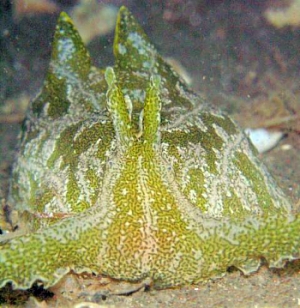
Thanks Danny,
It is nice to get another record of this very chracteristically shaped and coloured sea hare.
Best wishes,
Bill Rudman
Syphonota geographica from Dominica
July 23, 2004
From: Linda Ianniello
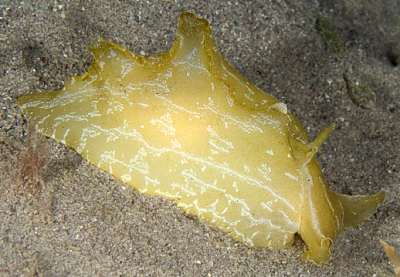
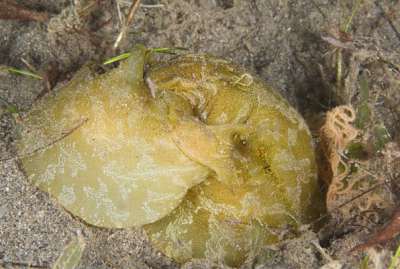
Dr. Bill,
Here are two shots of Syphonota geographica that I recently found in the Caribbean.
Location: Dominica, Eastern Caribbean
Sea grass bed off Castle Comfort Hotel
Depth: 20 to 25 feet
Date: July, 2004
Size: approximately 4 inches
We saw several of them each night, but none during the day. They were crawling in the sand around the sea grass, but I didn't see any evidence of what they were actually feeding on. One shot shows two together, with eggs. I hope this helps prove it is 'circumtropical' and extends its reported range!
I really miss looking at your updates to the Forum every day, but am very glad to see that you are finding the time to add a few items each week. I'm sure it is taking away from your free time, but the Forum is such a great resource that we do appreciate your efforts
Regards,
Linda I.
lindai@us.ibm.com
Ianniello, L., 2004 (Jul 23) Syphonota geographica from Dominica. [Message in] Sea Slug Forum. Australian Museum, Sydney. Available from http://www.seaslugforum.net/find/12702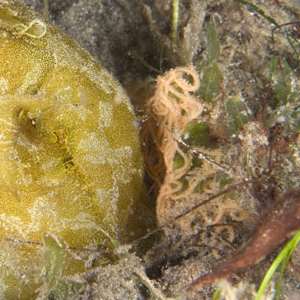
Dear Linda,
This is indeed an interesting find. It is not mentioned in Eveline Marcus's review of the western Atlantic Anaspidea (1972) and I certainly could not find any early records of this species from the Caribbean when I looked some time ago. So as you say this is a new find for the Caribbean and does indeed give the species a circumtropical distribution. The question that must be considered is whether this is a recent arrival, as I suggested from Mediterranean records on the Forum [#8637], or is it a species which has been overlooked in the past?
• Marcus, Ev. (1972) On the Anaspidea (Gastropoda: Opisthobranchia) of the warm waters of the western Atlantic. Bulletin of Marine Science, 22(4): 841-874.
Concerning the Forum. Hopefully I can aim at a few messages daily. Your message again illustrates just how shortsighted are those that hold that the Forum is not a valuable source of new scientific information.
Best wishes
Bill Rudman
Syphonota geographica from Changi, Singapore
February 5, 2003
From: Ria Tan
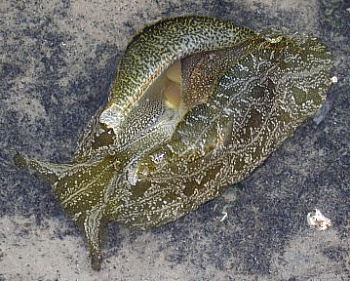
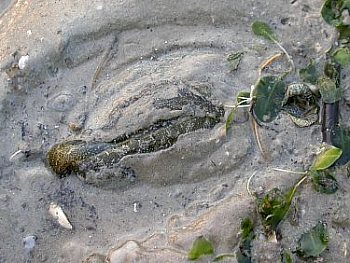
Dear Bill,
As well as the sea slugs from Chek Jawa, here is one from the intertidal flats at Changi, here in Singapore. Anything you can tell us about it would be very interesting.
Best wishes,
Ria Tan
tanria@singnet.com.sg
Tan, R., 2003 (Feb 5) Syphonota geographica from Changi, Singapore. [Message in] Sea Slug Forum. Australian Museum, Sydney. Available from http://www.seaslugforum.net/find/9109Dear Ria,
This is an unusual Sea Hare called Syphonota geographica. Its name geographica refers to the map-like markings on its body. These two photos show an interesting aspect of its behaviour which I don't think has been reported before. In an earlier message I summarise what I have been able to find on burrowing in Sea Hares. It seems that a number of species spend some time buried in the sand. In intertidal regions this is probably a good way to prevent drying out, and I guess it is also a way to hide from potential predators.
Best wishes,
Bill Rudman
Re: Syphonota geographica from Italy
December 18, 2002
From: Erwin Koehler
Dear Bill,
Concerning Gianni Neto's Italian record of Syphonota geographica, Gianni has checked his archive, here is his reply: "The photo has been made in the Strait of Messina two years ago in September ... After that time I do not have more of them found again."
By the way, Gianni has excellent uw-shots at his website http://digilander.iol.it/netofotosub
Cheers,
Erwin
Erwin@medslugs.de
Thanks Erwin & Gianni,
It is indeed an interesting observation. If anyone else has seen this animal in the Mediterranean or knows of a published report of it being found there, I would be very pleased to hear of it
Best wishes,
Bill Rudman
Re: Syphonota geographica from Turkey
December 13, 2002
From: Erwin Koehler
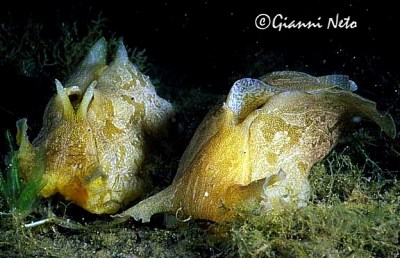
Dear Bill,
Regarding the message from Turkey. This species is labelled in my books as Phyllaplysia lafonti. Attached is a shot from Italy by Gianni Neto [gianeto@libero.it]. No other data were recorded.
Cheers Erwin
Erwin@medslugs.de
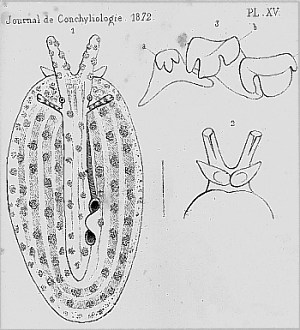
Dear Erwin,
Gianni Neto's photo is also Syphonota geographica, which certainly suggests it is spreading throughout the Mediterranean. It would be nice to have some locality and date information.
I have checked up on Phyllaplysia lafonti (Fischer, 1870) and it seems to be a good Phyllaplysia. The most obvious difference between it and Syphonota is the much flatter body and the lack of parapodia, except as small flaps over the very small mantle cavity. I have included a scan of Fischer's original drawing [1872 - Plate 15, figs 1-3] to illustrate the difference. Compare this with my photo showing the opened parapodia on the Syphonota geographica Fact Sheet. There are some good colour photos of what seems to be correctly identified Phyllaplysia lafonti in an article by Terreni (1997) in La Conchiglia.
• Fischer, P (1870) Observations sur les Aplysies. Ann. de Sci. Nat (5). Zool & Pal, 13: 3
• Fischer, P (1872) Description d'une espece nouvelle du genre Phyllaplysia. Journal de Conchyliologie, 20: 295-301.
• Terreni, G. (1997) Rinvenimento di un esemplare di Phyllaplysia lafonti (P. Fischer, 1870) nelle acque litorali di Livorno (Gastropoda, Opisthobranchia, Aplysiomorpha). La Conchiglia, Roma, 29 (282): 45-47.
Best wishes,
Bill Rudman
Syphonota geographica from Turkey
December 12, 2002
From: Ferda Buyukbaykal
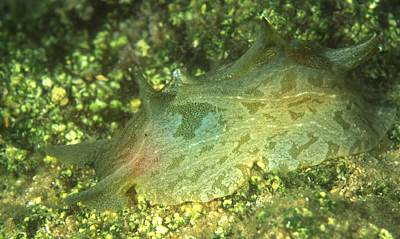
Hello Bill,
I found a new nudibranch in Fethiye [Mediterranean coast, Turkey] this week end. It was 10 mt deep , sandy/stone bottom and 10 -12 cm. I think its name is Aplysia fasciata. Is that correct.?
Ferda Buyukbaykal
ferdabbaykal@isnet.net.tr
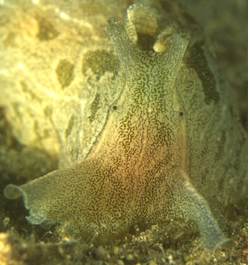

Dear Ferda,
This is another interesting find. It is a Sea Hare but not a species of Aplysia. It is Syphonota geographica which is another species from the Indo-West Pacific which has apparently made it through the Suez Canal into the Mediterranean - another lessepsian migrant. I hesitate to say this is the first record of it from the Mediterranean but I have been unable to find it listed in any publication available to me. Eales (1960) lists Syphonota geographica as being 'circumtropical' but gives no localities. I am unable to find any reference to this species being found anywhere in the Atlantic
• Eales, N.B. (1960) Revision of the world species of Aplysia (Gastropoda, Opisthobranchia). Bulletin of the British Museum (Natural History), Zoology, 5(10): 267-404.
Best wishes,
Bill Rudman
Syphonota from Sydney
June 1, 2000
From: Akos Lumnitzer
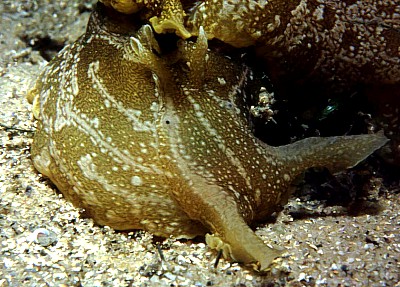
Dear Bill,
Is this Notarchus indicus? It is from Camp Cove, Sydney Harbour [New South Wales, Australia] night dive in July 1998, two meters of water amongst the seagrass beds.
Akos
dna72@softhome.net
Lumnitzer, A., 2000 (Jun 1) Syphonota from Sydney. [Message in] Sea Slug Forum. Australian Museum, Sydney. Available from http://www.seaslugforum.net/find/2486Dear Akos,
This is Syphonota geographica, which is a rather distinctly shaped and coloured Sea Hare. It differs from species of Aplysia in having the rhinophores (head tentacles) set back almost between the parapodial flaps rather than in front of them. [see photo].
In older Australian books and scientific publications the name Paraplysia piperata was used for this species, but it is a synonym.
Best wishes,
Bill Rudman.
Is Syphonota found in Australia or NZ?
May 26, 1999
From: P.M. Johnson
Dear Bill,
Quick question for you - Can the sea hare Syphonota a.k.a Paraplysia be found in Australia and/or New Zealand? If so, do you know of any good sites and times to find it.
Thanks much,
pm
pmj@u.washington.edu
Johnson, P.M., 1999 (May 26) Is Syphonota found in Australia or NZ?. [Message in] Sea Slug Forum. Australian Museum, Sydney. Available from http://www.seaslugforum.net/find/888Dear pm,
It's certainly been recorded from Sydney Harbour in eastern Australia north through Queensland and the Northern Territory to Western Australia, but I'm afraid its habitat, sea grass beds, estuaries etc are not my normal hunting ground so I haven't a good idea of its abundance. I suspect, like many aplysiids, its sometimes extremely abundant. Perhaps someone will recognise it from the photos I've posted from New Caledonia and be able to give us some more information.
Best wishes,
Bill Rudman.
PS: A good reference on aplysiid distributions in the Pacific is:
• Bebbington, A. (1977). Aplysiid species from eastern Australia with notes on the Pacific Ocean Aplysiomorpha (Gastropoda, Opisthobranchia). Transactions of the Zoological Society, London, 34: 87- 147.
